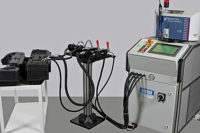For a broad range of automotive, medical and other products, leak testing requirements before products are released to the marketplace have not changed. What has changed in recent years is several new technologies—some related to data handling and the Industrial Internet of Things and others relating to test techniques—that now change the calculus of determining best-match solutions for leak testing.
In this article we will do a quick review of pressure decay and mass flow leak testing methods, and then explore the new technologies impacting decisions on how to best configure leak test systems.
Pressure Decay Testing vs. Mass Flow Testing
Many make the mistake of equating the upfront costs of a leak tester instrument with the costs of the leak testing in total. Over the economic life of a leak tester, the upfront costs of the test instrument are a mere fraction, often trivial, of the overall testing costs. The lower costs of pressure decay test instruments—where the change in pressure in a closed system due to a leak is quantified—are such that historically many manufacturers had, and still do, use this test method.
However, pressure-decay leak testing, though relatively cheap and easy has many disadvantages. Pressure decay measurements are highly vulnerable to changes in testing conditions, such as drafts or temperature. There are also often difficulties in determining the volume of test parts and test circuits, which must be known in order to calculate results. Also, pressure decay methods, including differential pressure decay methods, have hidden costs that derive from the need to make two measurements and then correlate results to determine a leak rate. Two measurements mean double the chances for measurement error. In addition, the longer the interval between the two measurements the higher the probability for measurement error—especially for leak testing large volume parts.
In contrast to pressure decay leak test methods, test instruments with mass flow sensors only require single direct measurements of leak rates. Unlike pressure decay sensors, mass flow test instruments aren’t encumbered with these built-in error sources and slower two-step test times inherent in pressure decay test methods.
Updates to Mass Flow Test Methods
When accuracy and cycle time requirements are not that stringent, pressure decay testing or differential pressure decay testing may be a better choice or at least a very reasonable one if there is no compelling reason to update test technology. However, if and when accuracy and test cycle time are critical concerns, it’s important to know the various ways in which mass flow test methods have been improved in recent years.
Customized Sensor Technology
Updated mass flow sensors that are tuned to the very precise testing conditions required achieve both shorter test cycles and higher accuracy. These updated sensors—unlike generic sensors—maintain high measurement accuracy across a wider range of air pressures and temperatures, ambient temperatures, and random, short-duration disturbances in measured airflow. Consider, for example, that the manufacturers of fuel regulators that must perform in both high temperature and high-pressure environments face a very different leak testing challenge than do manufacturers of sealed packages of sensitive electronics.
Patented Innovations for Large Part Testing
Mass flow test methods have also been improved in recent years in ways that especially impact the speed and accuracy of leak testing large parts. Two new approaches that speed test cycles target the stabilization phase of a test cycle—the slowest part of a leak test, even with mass flow methods. One newly patented test technique eliminates turbulence to help speed the stabilization phases of test cycles. Another new approach to reducing stabilization times and variation is by extracting the warm unstable air from the test part and replacing it with stable air, at the correct test pressure, that is ready to be measured for the leak rate value.
Methods for Early Pass/Fail
The newly available high precision mass flow sensor technology can also be combined with real-time analysis that determine early in a test cycle that a part is clearly in or out of specification. These rapid pass/fail determinations are impossible with pressure decay leak test methods. Here too, the impact of these methods are often most significant in speeding test cycles for large volume parts—30% reduction in test times is not uncommon.
Robotics and Calibrations
The more advanced manufacturing operations that have invested in robotics are finding that this can also impact leak testing. The variability that human operators can introduce in using a master part leak test for calibrations is usually captured in gage R&R standards. However, robots have a distinct advantage in that they can load masters in exactly the same way and at precisely correct times during automated setups. Robots also can initiate calibrations and verification cycles. This is the case whether sophisticated calibration instruments that can easily provide adjustable leak rates are used or less flexible systems that simply use masters with calibrated orifices.
Harnessing IoT Benefits
Best in class leak testers—usually with Ethernet-IP capability—can be easily integrated into an Industry 4.0 environment. Best-in-class single measurement mass flow leak test sensors are ideally suited for cloud systems as is required for the Internet of Things (IoT).
This especially impacts quality systems. When leak test data is automatically shared via the cloud and additional statistical modeling of test data is performed, these sensors in an IoT environment can alert managers of upstream operations very quickly of quality problems needing attention.
Summary
If your products require leak testing, but your leak test technology is five years old or older, it is highly likely that the ROI of investing in newer generation test instruments and related technologies will be rapid.

